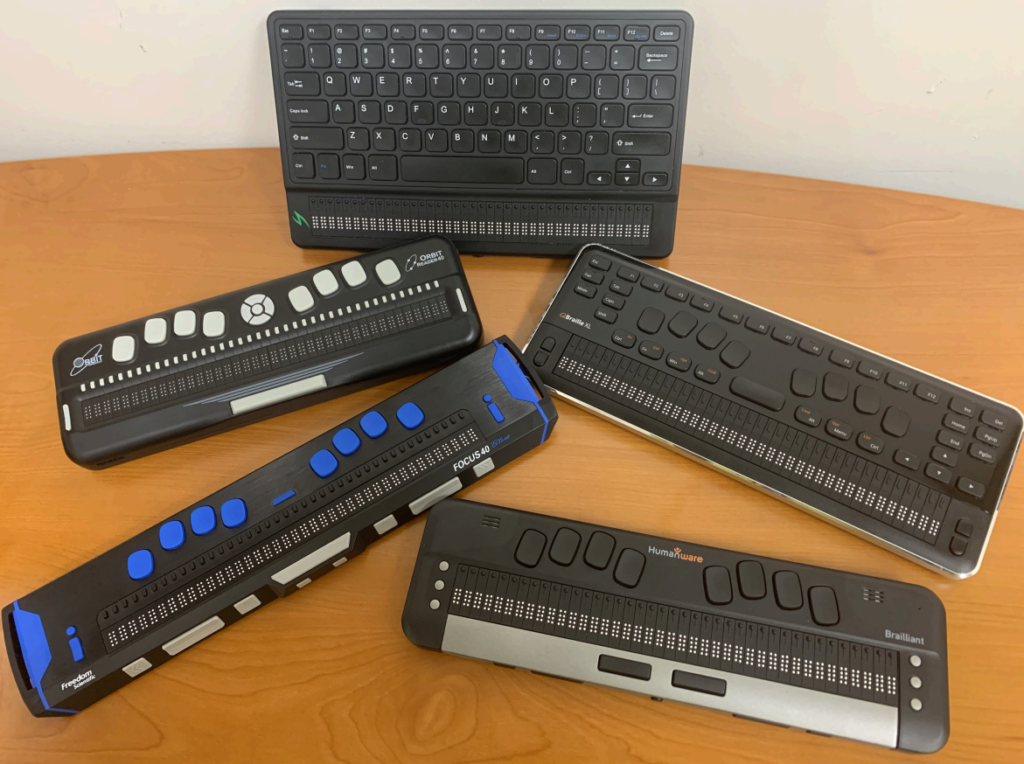40 Cells to Empowerment: A Comparison of Five Braille Displays to Fortify Your Success in 2023
Read Scott Davert's reviews where he compares 5 braille displays and showcases their different internal features, costs, battery life and more.

By Scott Davert, Coordinator: Technology, Research and Innovation Center, Helen Keller National Center for DeafBlind Youths and Adults
January 18, 2023
Introduction
There are several 40 cell braille devices on the market providing different feature sets at varying price points. At the time of this writing, these displays range in price from $1,499 to $3,695. As the monetary investment is seldom trivial even on the lowest end, it is important to find the ideal device to fit a person’s specific circumstances. If you would like to compare this article to the one published in 2021, you can still find the previous version here.
To help decide which is best for your specific needs, this article will provide the following information for each device: Price, internal functions, battery life, types of memory, supported file types, type of keyboard, turnaround time on support requests and my own evaluation. Prices are accurate as of January 2023. This article covers devices available in the United States. Links to comprehensive reviews will be provided in the comment section. Support requests were submitted to the general email address under a random name and were done in December 2022. Evaluations of battery life were done using Bluetooth as the connection protocol. Your mileage will vary based on the amount of use of wireless devices. All displays are capable of one USB connection, and when connected through USB, provide the option to recharge while in use.
Brailliant BI 40X
Manufacturer: Humanware
Cost: $3,695
Internal features: Text-To-Speech, Editor, clock, calculator, book reader, WiFi for direct access to Bookshare, the NLS BARD braille collection and NFB Newsline, file manager and connection manager for Bluetooth connections
Battery life: 14-17 hours
Types of supported memory: Flash drives and 32 GB of internal memory
Supported file types: BRF, TXT, DOCX, PDF, Daisy text and Bookshare zip files
Type of keyboard: Perkins
Number of Bluetooth connections: 5
Turnaround time on support request: Less than 1 business day
Comments: Reviewed on the TRIC blog in April 2021, the Brailliant BI 40X is the only device supporting direct download from the NLS BARD braille books service and is also the only device listed which has built-in text-to-speech. Though the feature set is very similar to the Mantis Q40, the Brailliant BI 40X sports a Perkins style keyboard. Like the Mantis Q40, it is possible to hit a cursor routing button to wake up an iOS or iPadOS device. Though APH and Humanware are investigating methods for bringing audio support to the Mantis, this is not guaranteed. As of iOS 16.2, the latest release on writing, the Brailliant does have some unique challenges related to editing of text and adding new lines while composing in a text field, though these challenges do have workarounds which are less productive. For those on Android, you will need to run TalkBack 13.1 to get braille support with the Brailliant, and this only exists at the time of writing over USB.
Focus 40 Blue
Manufacturer: Vispero
Cost: $3,302.25
Internal functions: Clock, Scratchpad, menu, calendar (for checking the date only) and menu.
Battery life: 18-20 hours
Types of supported memory: Micro SD cards up to 32 GB
Supported file types: BRF, BRA and TXT
Number of Bluetooth connections: 5
Type of keyboard: Perkins
Turnaround time on support request: 2 business days
Comments: I reviewed the Focus 40 Blue in detail in the April 2018 issue of AccessWorld. This display seamlessly integrates with JAWS for Windows and also works well with NVDA, Android and iOS. Dedicated commands for switching between connected devices offers a much-appreciated productivity boost. This is the only device to require a Windows PC running JAWS to update the firmware which some may find inconvenient. Though the Focus can transfer files to and from a PC, it’s not possible to use the braille display with USB while in Mass Storage mode. The user needs to be connected over Bluetooth or braille support is lost. If you want to move notes taken in the Scratchpad to another device, the TXT file must be written in eight-dot braille. The export feature allows you to move contracted braille notes taken on the Scratchpad to Windows but it is unreliable on iOS. Reading plain text files on the Focus must also be done in eight-dot braille. It is still being updated with the most recent release adding the ability to save files in formats other than the proprietary format such as plain text or digital braille. The other displays seem to all have a way to receive news from the manufacturer, but Vispero does not have such a mechanism for disseminating information about updates to the Focus. The best way to check for an update is to visit the firmware update page on the Vispero website. Like the Orbit Reader 40, the Focus does not have internal memory. Lack of internal memory also means that when you remove the Micro SD card to send it in for repair, you still have your files with you. Unlike the Orbit Reader 40, it also has the option to save files in a proprietary format. Some may see this as a positive thing since this format allows for you to have files that cannot be opened on any other device. This means that the user can store sensitive information on the Focus securely.
Mantis Q40
Manufacturer: APH/Humanware
Cost: $2,682
Internal features: Editor, clock, calculator, book reader, WiFi for direct access to Bookshare and NFB Newsline, file manager and connection manager for Bluetooth connections
Battery life: 14-17 hours
Types of supported memory: SD cards, flash drives, and 16 GB of internal memory
Supported file types: BRF, TXT, DOCX, PDF, Daisy text and Bookshare zip files
Type of keyboard: Laptop-style QWERTY
Number of Bluetooth connections: 5
Turnaround time on support request through APH: 2 business days
Comments: Reviewed in the August 2020 issue of AccessWorld, the Mantis has a QWERTY keyboard. Built-in access to Newsline and Bookshare are certainly a perk and the learning curve when working with Windows or the Mac should not be as steep if you are already familiar with the standard keyboard commands for your operating system and screen reader. Updating can be accomplished using the internal WiFi connection or by transferring the update file to an SD Card or thumb drive. Though the Mantis Q40 supports the reading of many file types, editing a document will result in a plain text file when saved, unless the Braille Editor application is used. The Braille Editor requires the ability to enter text by using SDF and JKL to input braille. The keyboard will not function as a QWERTY one in this application. Like the Orbit Reader 40, the Mantis does not come with a case that can be used while on the go, though arguably, a 40 cell display is not the most portable device anyway. At the time of writing, the Mantis and Brailliant still lack Android support through Bluetooth, unlike the Focus, Orbit Reader and QBraille. Turning off WiFi when not in use will get the battery running time closer to 17 hours.
Orbit Reader 40
Manufacturer: Orbit Research
Cost: $1,499
Internal features: Editor, book reader, clock, calendar, terminal, calculator and File Manager
Battery life: 20-22 hours
Types of supported memory: SD card and thumb drive
Supported file types: BRF, BRL and TXT
Type of keyboard: Perkins
Number of Bluetooth connections: 5
Turnaround time on support request: Less than 1 business day
Comments: Reviewed on the TRIC Blog in October 2021, the Orbit Reader 40 is the least expensive 40 cell braille display on the market. It also is the device with the longest battery life, according to my testing. It was made to emulate the VarioUltra 40, which makes it immediately useable with most screen readers dating back several years. As noted above, neither the Brailliant or Mantis have support for Android, Fire OS and older versions of screen readers which Humanware could have addressed through some form of emulation. This could have even been an emulation of the old Brailliant BI 40. As mentioned in my review, the fact that the braille cells are so solid and sharp means that some individuals who may not be able to read braille on paper or with other devices may find the Orbit Reader 40 to be a viable option. I found the keyboard to be quite an adjustment for typing, as the keys have a further distance to travel when pressed. This also makes the keyboard louder than the others on the market. Updating can be done with an SD card or thumb drive. Like the Focus and QBraille, the Orbit Reader 40 does not contain any internal memory.
QBraille XL
Manufacturer: HIMS Inc.
Cost: $3,195
Internal features: Notepad, DAISY Reader, clock, stop watch, alarm, calendar and Terminal Mode
Battery life: 16-18 hours
Types of supported memory: SD card
Supported file types: BRF, BRL, TXT, RTF, DOCX, PDF and DAISY text
Type of keyboard: Hybrid
Number of Bluetooth connections: 6
Turnaround time on support request: 2 business days
Comments: Reviewed in the September 2020 issue of Access World, the QBraille is the only device which has not increased in price since this article was last updated in November 2021. The hybrid keyboard combines a Perkins style keyboard with what HIMS considers to be the essential keys on a QWERTY keyboard.
Though I reported in the linked review that I was experiencing trouble with the Bluetooth connection when using JAWS, this seems to have been resolved in the update HIMS released in November 2020. The user has the option of whether they wish to use the hybrid mode or simply use the display as though it only had a Perkins style keyboard. It also has the ability to edit both plain text and BRL formatted files, unlike the Brailliant BI 40X and Mantis. The QBraille XL also has keyboard commands to move among connected devices, commands to jump directly from one application to another, the option to have the display boot into a few applications other than the main menu and more direct keyboard support for navigation of DAISY text files. Updating can be done internally via the SD card. It does not have the ability to download content since it does not have a WiFi module. I’m still not able to jump by more than one window using the Alt + Tab keyboard combination with Windows. With VoiceOver, though, I’m able to use the Caps Lock key as a VoiceOver modifier in both Mac OS and iOS unlike what was listed in the review.
Conclusion
There are many devices on the market that seek to become the go-to 40 cell braille solution. These displays, while not stand-alone notetakers, are more feature-rich than ever before. Each has a few benefits that the others do not. Some of these minor differences can be a deciding factor when choosing a device. For example, the choice of a keyboard may make a certain device the best tool for the job. Though the user has their choice of Perkins style keyboards, there is only 1 option for those wishing to use a QWERTY keyboard. A reader asked me why I didn’t discuss the feel of the dots on the braille displays. This is subjective, and while I hope the provided information is useful, nothing can ever match the opportunity to experience these devices firsthand. As this is not possible for most, I hope that this content has been helpful in guiding and simplifying the decision-making process.


